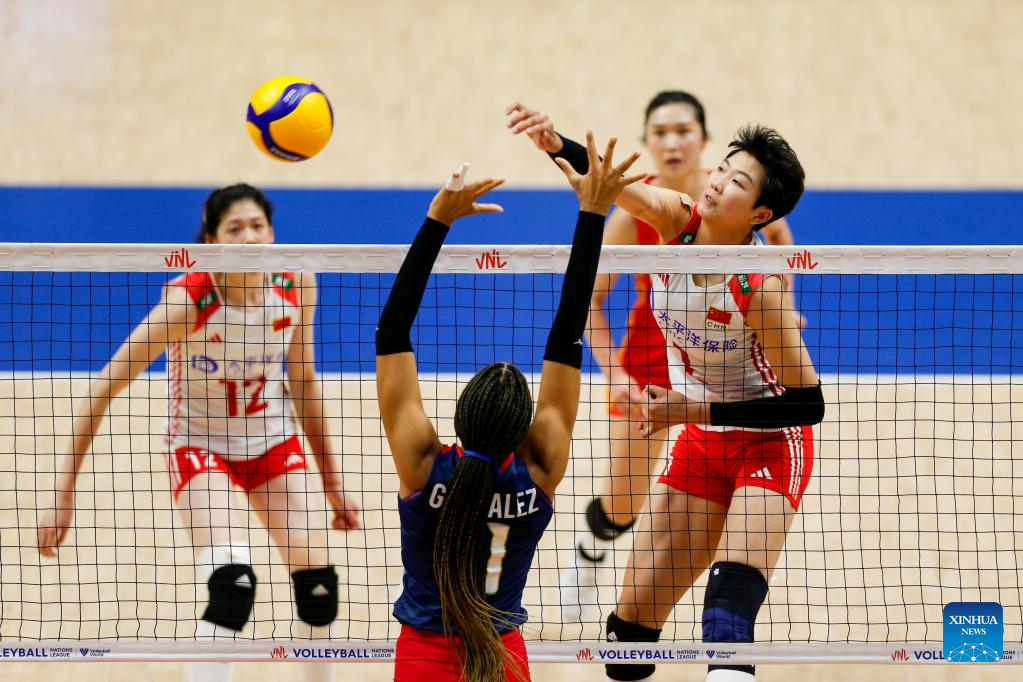
 0 Comment(s)
0 Comment(s) Print
Print E-mail Xinhua, July 22, 2024
E-mail Xinhua, July 22, 2024
The significant changes to volleyball's competition format at the Paris Olympics may lead to heightened intensity and drama. With the group stage reduced from five matches to three and modifications in the knockout stage matching mechanism, all teams are bracing for unprecedented competition.
The reformed structure features 12 teams divided into three groups, with the top two teams from each group and the two best third-place teams advancing to the knockout stage. The reduction of group stage matches from five to three means teams must hit the ground running, with little time to adjust to the high-stakes Olympic environment.
This format sets the stage for potentially the most fiercely contested Olympic volleyball group stages in history.

Yuan Xinyue (R) of China spikes the ball during the 2023 Volleyball Nations League match against Dominican Republic in Suwon, South Korea, June 30, 2023. (Xinhua/Wang Yiliang)
In the women's competition, Group A includes China, France, the United States and Serbia. Group B consists of Brazil, Poland, Japan and Kenya, while Italy, Turkey, the Netherlands and the Dominican Republic comprise Group C.
Group A and Group C each feature multiple title contenders, promising final-worthy matchups in the early rounds, such as China and Serbia against the U.S., and Italy taking on Turkey.
The men's competition features Canada, France, Slovenia and Serbia in Group A, Brazil, Egypt, Italy and Poland in Group B, and Argentina, Germany, Japan and the United States in Group C.
Anticipation is high for intense group stage clashes, like world fourth-ranked France against fifth-ranked Slovenia, and world number one Poland against Italy.
Teams advancing from the group stage will face dramatic knockout rounds. The quarterfinals will pair teams based on overall group stage performance, with the first seed facing the eighth seed, the second seed facing the seventh, and so on.
Ranking by overall group stage performance may prevent strategic losses, but it also means that group stage rivals might meet again in the knockout rounds, adding a layer of unpredictability to the quarterfinals.
Among the women's teams, Italy, Turkey, Brazil and Serbia are the gold favorites. The three European teams are known for their power-oriented playing styles, capable of disrupting opponents' receiving systems and quickly turning points. This trend reflects a new technical preference in world volleyball since the Tokyo Olympic cycle.
Italy, with a balanced offense and defense, are widely regarded as the top contenders for gold.
Despite an older roster, Brazil's 12-match winning streak in this season's Volleyball Nations League showcases their current form.
Reigning Olympic champions the United States are also potential title challengers, along with China. However, both teams lack new faces, making their tactics and player strengths well-known to their competitors.
China's additional challenge is the decline in form of star spiker Zhu Ting. Although Zhu, a key figure in China's 2016 Rio gold victory, has rejoined the national team, her lingering injuries and limited recent match experience may cause problems.
In the men's competition, the focus will be whether host nation France can defend their Olympic title.
France's recent form, including a World Volleyball League title, suggests they are in excellent shape. However, as a nation without a deep men's volleyball tradition, their true strength will only be revealed under Olympic pressure.
Before their Tokyo 2020 win, France were never considered Olympic medal contenders, but now they are no longer underdogs.
The only Asian team to qualify for the Paris Olympics men's volleyball, Japan have also garnered significant attention. Ranked second globally, Japan's performance against European and American teams remains a captivating storyline for volleyball fans.
The Paris Olympics volleyball competitions will run from July 27 to August 11, with the men's starting on July 27 and ending on August 10, and the women's playing from July 28 to August 11.